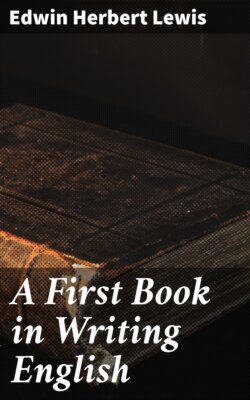Читать книгу A First Book in Writing English - Edwin Herbert Lewis - Страница 4
На сайте Литреса книга снята с продажи.
INTRODUCTORY EXPLANATIONS
ОглавлениеTable of Contents
Our plan provides for a good many short compositions. These, as well as all other exercises, should be written on uniform theme-paper,[4] say eight inches by ten, with a broad margin at both sides. There are advantages in the double margin. First, it is easier for the reader of the theme to jot down his suggestions at the right, since he need not turn the paper to do so. Secondly, it is well for the student to learn the knack of keeping a straight edge at the left hand. Only one side of the paper should be written on. If a mistake is made, a heavy line may be drawn through the word. The manuscript ought to present the neatest possible appearance. Blank spaces are to be avoided at the end of lines, except where a paragraph ends. The straight edge, referred to above, is to be scrupulously preserved at the left of the page, except that when a new paragraph (that is, division of the theme) is to begin, the first line of it should start about two inches farther to the right than the other lines. The pages should be carefully numbered in the upper right-hand corner, and kept in their proper order. Nothing is more disconcerting to any person who reads a manuscript than to open the paper and find before him the last page, rather than the first. Every theme should have a definite title. This should appear in the blank space at the top of the first page and in the endorsement of the folded paper, on the back of the last page. The theme should be folded once, lengthwise. In the blank space at the top should be written the endorsement, which should follow this model: (1) name; (2) name of course; (3) title; (4) date.
Richard Doe.
First year English.
A Dialogue on Politics.
Oct. 1, 189-.
After the themes have been read, whether by the instructor alone or by the class and the instructor, they will be returned with marginal comments, and (just under the endorsement) a summary of these comments. In many cases the student will be expected to rewrite, and the word Rewrite will appear with the general comment. Otherwise he will be expected to Revise, that is, to interline corrections and improvements on the manuscript without copying it.
Each student’s papers will be filed and kept. He will often be asked to consult with the instructor concerning his own progress, as shown by his bundle of themes.
The following suggestive signs[5] may be used in the margin of themes, indicating the presence of errors, the actual errors to be discovered by the pupil for himself. Some teachers will prefer a simpler system of symbols, some a more elaborate system. The suggested list can easily be modified or supplanted.
| Ms. | Bad manuscript. |
| ✓. | Some obvious fault—a mark which will be used more and more frequently as the student’s knowledge increases. The check-mark will frequently indicate bad spelling or punctuation, or fault in capitalizing. |
| Sp. | Bad spelling (see under check-mark). |
| Hy. | Fault in use of hyphen. |
| P. | Fault in punctuation (see also under check-mark). |
| Cap. | Fault in the use of a capital letter (see check-mark). |
| L. | Too loose; structure rambling. |
| S. | Solecism. |
| C. | Structure incoherent. |
| E. | Lack of emphasis in sentence. |
| U. | Lack of unity in sentence. |
| Tr. | Transpose order of words. |
| V. | Vague. |
| A. | Ambiguous. |
| ¶U. | Lack of unity in paragraph. |
| ¶. | Proper place for a paragraph. |
| (. | Run two paragraphs together. |
| []. | Passages within brackets to be omitted. |
| . | Dele, take out, omit; a mark used in correcting printer’s proof. |
| |. | Against a passage requiring to be wholly recast. |
| Ri. | Unnecessary repetition of idea. |
| ?. | Questions truth of statement. |
| B. | Barbarism. |
| I. | Impropriety. |
| W. | Wordy. |
| H. | High-flown, inflated, or over-ambitious. |
| D. | Consult the dictionary. |
| Hack. | Hackneyed. |
| Bw. | Better word needed—a more exact or appropriate word. |
| Rw. | Unnecessary repetition of a word. |
| M. | Metaphors mixed, or other fault in the use of figures of speech. |
| K. | Awkward, ugly, or unpleasing. |
| Bt. | Bad taste. |
A strong notebook of portable size is needed for the work in spelling and vocabulary. It should be used from the first for noting new words, etc. See page 199.
